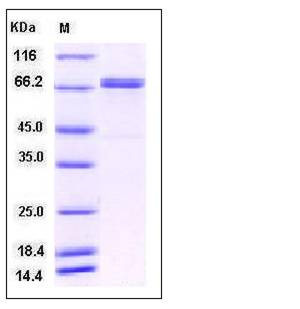Human LRRN3 Protein (His Tag)
FIGLER5,NLRR-3,NLRR3
- 100ug (NPP4063) Please inquiry
| Catalog Number | P11610-H08B |
|---|---|
| Organism Species | Human |
| Host | Baculovirus-Insect Cells |
| Synonyms | FIGLER5,NLRR-3,NLRR3 |
| Molecular Weight | The recombinant human LRRN3 consists of 616 amino acids and predicts a molecular mass of 70 kDa as estimated in SDS-PAGE under reducing conditions. |
| predicted N | Met 1 |
| SDS-PAGE |  |
| Purity | > 90 % as determined by SDS-PAGE |
| Protein Construction | A DNA sequence encoding the human LRRN3 (AAH35133.1) extracellular domain (Met 1-Thr 628) was fused with a polyhistidine tag at the C-terminus. |
| Bio-activity | |
| Research Area | Developmental Biology |Embryogenesis |Germ Layer Formation |Ectoderm Marker |
| Formulation | Lyophilized from sterile 20mM Tris, 500mM NaCl, pH 7.0, 10% gly 1. Normally 5 % - 8 % trehalose and mannitol are added as protectants before lyophilization. Specific concentrations are included in the hardcopy of COA. |
| Background | Leucine-rich repeat neuronal protein 3, also known as neuronal leucine-rich repeat protein 3 (NLRR-3), is a member of leucine-rich (LRR) family whose members have significant functions in neural development. Leucine-rich repeats are short sequence motifs present in a number of proteins with diverse functions and cellular locations. All proteins containing these repeats are thought to be involved in protein-protein interactions. The crystal structure of ribonuclease inhibitor protein has revealed that leucine-rich repeats correspond to β-α structural units. These units are arranged so that they form a parallel β-sheet with one surface exposed to solvent, so that the protein acquires an unusual, non-globular shape. These two features may be responsible for the protein-binding functions of proteins containing leucine-rich repeats. LRRN3 plays an important role in cerebellum postnatal development. In a unilateral cortical injury cerebral cortex, NLRR-3 mRNA increased in layers 2-3 which suggests that NLRR-3 may be an important component of the pathophysiological response to brain injury. |
| Reference |
